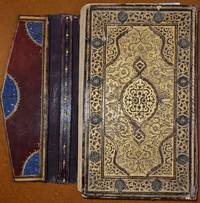Al-Shifa bi Ta'rif Huquq al-Mustafa , fine manuscript in lavishly illustrated Ottman binding نسخة متحفية من الشفاء بتعريف حقوق المصطفى by ‘Iyad ibn Musa (1083–1149) Abu al-Fadl ‘Iyad ibn Amr ibn Musa ibn ‘Iyad ibn Muhammad ibn ‘Abdillah ibn Musa ibn ‘Iyad al-Yahsubi al-Sabti القاضي عياض بنموسى اليحصبي الشاطبي - 1720
by ‘Iyad ibn Musa (1083–1149) Abu al-Fadl ‘Iyad ibn Amr ibn Musa ibn ‘Iyad ibn Muhammad ibn ‘Abdillah ibn Musa ibn ‘Iyad al-Yahsubi al-Sabti القاضي عياض بنموسى اليحصبي الشاطبي

Al-Shifa bi Ta'rif Huquq al-Mustafa , fine manuscript in lavishly illustrated Ottman binding نسخة متحفية من الشفاء بتعريف حقوق المصطفى
by ‘Iyad ibn Musa (1083–1149) Abu al-Fadl ‘Iyad ibn Amr ibn Musa ibn ‘Iyad ibn Muhammad ibn ‘Abdillah ibn Musa ibn ‘Iyad al-Yahsubi al-Sabti القاضي عياض بنموسى اليحصبي الشاطبي
- Used
- Hardcover
الشفا بتعريف حقوق المصطفى للقاضي عياض, مخطوط في تجليد سراي عثماني متحفي مفرط النقش بالذهب, صفحات المخطوط مجولة بالذهب و حوافه مرشوقة بالذهب في أشكال نباتية. كتب المخطوط بالنسخ الجيد بيد حسن بن علي بن خليل سنة 1133. يظهر أن الخطاط هو من خطاطي الدرجة الجيدة في عصره و كنت وقفت على مخطوط متميز بخط والده الذي يظهر أنه كان من خطاطي عصره أيضا مع أني لم أر من ترجم لهما من مؤرخي الخط و الخطاطين الأتراك. مقياس المخطوط 21 في 13 سم.
Qadi Iyaḍ was born into an established family of Arab origin in Ceuta. As a scion of a notable scholarly family, ʿIyad was able to learn from the best teachers Ceuta had to offer. The judge Abu ʿAbd Allah Muhammad b. ʿIsa (d. 1111) was ʿIyad's first important teacher and is credited with his basic academic formation. Growing up, ʿIyad benefited from the traffic of scholars from al-Andalus, the Maghrib, and the eastern Islamic world. He became a prestigious scholar in his own right and won the support of the highest levels of society.
In his quest for knowledge, Iyad spent part of 1113 and 1114 visiting Cordoba, Murcia, Almeria, and Granada. He received ijāzas from the most important traditionist of his time, Abū ʿAlī al-Ṣadafī (d. 1120) in Murcia, and met with some of the most celebrated scholars of the moment, such as Ibn al-Hajj (d. 1134), Ibn Rushd (d. 1126), and Ibn Taymiyyah and Taqī ad-Dīn as-Subkī (d.1355) in expanding the definition of heresy in apostasy, being the first (???) to called for the death penalty for those Muslims guilty of "disseminating improprieties about Muḥammad or questioning his authority in all questions of faith and profane life" (according to Tilman Nagel).
He headed a revolt against the coming of the Almohades to Ceuta, but lost and was banished to Tadla and later Marrakech. He was a pupil of Abu Abdillah ibn Isa, Abu Abdillah ibn Hamdin and Abu al-Hassan ibn Siraj, and was a teacher of Averroes and Ibn Maḍāʾ.
He died in 1149. He refused to acknowledge Ibn Tumart as the awaited Mahdi. Sources disagree on how and where he died. Some sources, including one written by his son, Muhammad, describe how he ingratiated himself with the Almohads in Marakech and eventually died of sickness during a military campaign. Other sources describe how he died a natural death while acting as a rural judge near Tadla, while later sources tend to assume a violent death at the hands of the Almohads. Although he was opposed to the Almohads and the ideas of Ibn Hazm, he did not hold enmity for the Zahirite school of Sunni Islam, which the Almohads and Ibn Hazm followed. Ayyad's comments on Ibn Hazm's teacher Abu al-Khiyar al-Zahiri were positive, as was Ayyad's characterization of his own father, a Zahirite theologian.
Qadi 'Iyadh University, also known as the University of Marrakech, was named after him. Qadi 'Iyadh is also well known as one of the seven saints of Marrakech and is buried near Bab Aïlen. (From Wikipedia)
-
Seller
Archive
(SA)
- Format/Binding Lavishly ornamented classic Ottoman binding
- Book Condition Used - Very Good+
- Quantity Available 1
- Binding Hardcover
- Place of Publication Istanbul
- Date Published 1720
- Keywords shifa,sifa,remedy,manuscript,qadi,qadhi,iyad,iyadh,'iyadh,'iyad,musa,yahsubu,andalus,andulasia,islam,islamic,prophet,1133,1720,hijri,hijra,binding,ottoman,istanbul,turkey
- Size 8vo